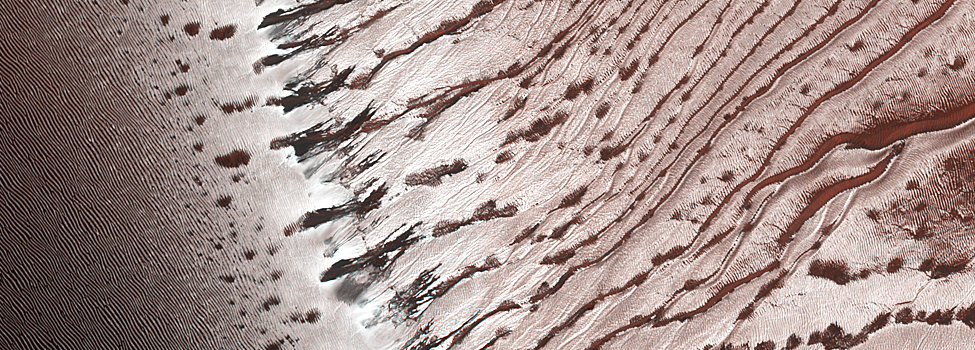Seasonal Processes Theme Description
Lead: Susan Conway •
Images in this theme
Mars’ seasonal polar caps are composed primarily of carbon dioxide frost. This frost sublimates (changes from solid directly to gas)
in the spring, boosting the pressure of Mars’ thin atmosphere. In the fall the carbon dioxide condenses, causing the polar caps to reach as
far as approximately 55 degrees latitude by late winter. In the study of seasonal processes we observe the caps as they wax and wane to
investigate both large scale effects on Mars as well as the local details of the sublimation and condensation processes.
By learning about current processes on a local level we can learn more about how to interpret the geological record of climate
changes on Mars. Mars Observer Camera (MOC) images from the Mars Global Surveyor spacecraft have shown an astonishing array of
exotic landscapes as the southern seasonal cap sublimates, including spots, “spiders,” and fans. A region we plan to investigate
near the south pole has been called the “cryptic” terrain because it seems to stay quite cold even after the disappearance of bright frost.
Major Science Questions for This Theme
What happens in the spring as the seasonal cap sublimes? What happens in the fall as frost condenses? What controls the extent
of the seasonal polar cap each year? What controls the sublimation and condensation of the seasonal frost on a local level
(topography, albedo of underlying terrain)? What is going on in the cryptic terrain
at the southern polar cap? How do dust storms affect the local weather at the polar cap edge? What are the wind patterns
and how do they change over the course of a season? Are geysers active as the caps sublimate? Is that what causes the spots and fans?
Relationship to Other Science Themes
This theme is closely related to the climate change and polar geology themes. Polar geology is primarily focused on the permanent
polar deposits in contrast to this theme which is concerned with behavior of the seasonal cap. Climate change is an extension
of seasonal processes in which we look for long-term trends that surpass seasonal variability.
Features of Interest Potentially Visible at HiRISE Scale
One example of many phenomena we would like to observe is the evolution of a “spot” to a “fan” as the seasonal cap retreats in
the spring. Is a spot formed in a locally dark region that gets warmer faster than its surroundings, then grows? Is the darker material
very fine and does it get blown across the surface of the brighter surrounding ice to form a fan? Or is the darker material
lofted by Triton-like plumes such as those observed by Voyager 2? The high resolution and high signal-to-noise ratio of the
HiRISE images along with stereo coverage will give us our best ever view of these unearthly terrains.
